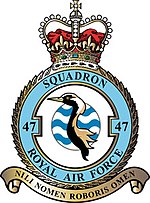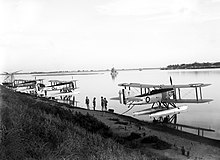| No. 47 Squadron RAF | |
|---|---|
 | |
| Active | 1 March 1916 – 1 April 1918 (RFC) 1 April 1918 – 7 October 1919 (RAF) 1 February 1920 – 21 March 1946 1 Sept 1946 – 31 October 1967 25 Feb 1968 – 21 September 2023 |
| Country | United Kingdom |
| Branch | Royal Air Force |
| Type | Flying squadron |
| Motto(s) | Nili nomen roboris omen (Latin for 'The name of the Nile is an omen of our strength')[1] |
| Battle honours | Macedonia (1916–1918)*, East Africa (1940–1941)*, Egypt and Libya (1942)*, Mediterranean (1942–1943)*, Burma (1945)*, South Atlantic (1982), Gulf (1991), Iraq (2003–2011)*, Afghanistan (2001–2014)*, Libya (2011)*
Honours marked with an asterisk may be emblazoned on the Squadron Standard[2] |
| Insignia | |
| Squadron badge heraldry | In front of a fountain, a demoiselle crane's head erased. The unofficial badge had been a sun rising over a pyramid, but tours in Russia and Sudan inspired the use of a crane (found in both countries) which, when navigating, flies high like a bomber. The fountain commemorates the amphibious role when seaplanes were flown off the River Nile. Approved by King George VI in November 1938. |
| Squadron Codes | EW (Apr 1939 – Sep 1939) KU (Sep 1939 – Sep 1942) (Feb 1945 – Mar 1946) |

No. 47 Squadron is an inactive squadron of the Royal Air Force. Formed in 1916, it saw service during the First World War in the UK and in Greece. Between the wars it served in Egypt and Sudan, and at the outbreak of the Second World war undertook bombing operations against Italian positions in Eritrea. Later it was based in Libya and Tunisia, taking part in anti-shipping operations in the Mediterranean. In 1944 the squadron moved to India, and began operations against the Japanese in Burma and elsewhere.
After the end of the war, it became a transport squadron, and returned to the United Kingdom. In 1968 it began a long association with the Lockheed Hercules, becoming part of the Lyneham Transport Wing. Subsequently it was based at RAF Brize Norton, Oxfordshire, until it was disbanded in 2023.
- ^ Pine (1983), p. 151
- ^ "47 Squadron". Royal Air Force. Archived from the original on 7 March 2015. Retrieved 18 July 2010.